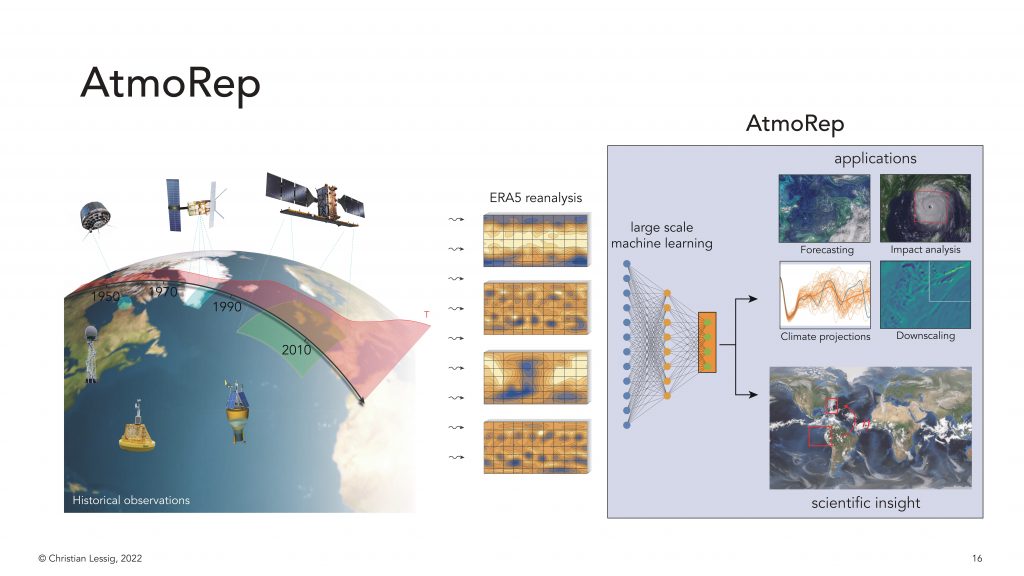Improving Weather Predictions with AI and Tackling Global Hunger
The atmosphere affects humans in a multitude of ways, from loss of life due to adverse weather effects, to altering crop yields and food stock, to other long-term social and economic impacts on societies. Tracking and understanding changes in the atmosphere and its effects is therefore vital.
While the common means of tracking and analysing atmospheric changes are well known, such as through the use of ground weather stations or satellite imaging from space, what is less known is how artificial intelligence has opened up new possibilities in weather forecasting and climate projections.
The Environmental Modelling and Prediction Platform (EMP2) project is part of a pioneering class of a small number of machine-learning based global environmental models trained on terabytes of data, that can be used to, for example, make predictions about the weather or track atmospheric dynamics. These models are known as foundation models.
EMP2 was one of eight initial projects to be selected for the CERN Innovation Programme on Environmental Applications (CIPEA) back in 2022 and is the first to be concluded. The project was supported by the CERN Knowledge Transfer Fund, and carried out by CERN openlab, in partnership with Magdeburg University, the Jülich Supercomputing Center and later the European Centre for Medium-Range Weather Forecasts (ECMWF).
AtmoRep can be adapted to several uses, including short-term weather forecasting, downscaling, bias corrections, spatio-temporal interpolations and probabilistic nowcasting.
A unique element of AtmoRep compared to other foundation models being developed is that it is stochastic, meaning that it can factor in random variables or processes in atmospheric conditions, mimicking the real-life complexity and arbitrary nature of atmosphere dynamics. It can also quantify the variability associated with a prediction, meaning the probability that a weather event will happen. CERN played a key role in the development of the stochastic approach as it has significant in-house expertise in uncertainty quantification of complex physics processes.

The AtmoRep model is now being used in several new projects.
The ECMWF will, for example, base the developments of its new WeatherGenerator project largely on AtmoRep ideas. The WeatherGenerator is intended to be a tool that can carry out a broad range of functions, from weather and climate predictions to renewable energy and flood prediction, amongst others.
“EMP2 has been the prototyping phase for the WeatherGenerator, which now will be able to start from a more mature level of understanding and leverage many ideas we used in EMP2 to push the limits of what has been done so far in terms of machine learning approaches for earth system modelling,” said Ilaria Luise, one of the principal investigators for the EMP2 project who now works for the ECMWF on the WeatherGenerator project.
AtmoRep is also being used in the HClimRep project that aims to combine information about the atmosphere, oceans and sea ice into one AI model in order to better predict climate changes. The project is a collaboration between leading climate researchers and AI experts from various institutions of Germany’s Helmholtz Association.
Another example comes from a recent partnership between CERN, the government of Luxembourg, the United Nations World Food Programme (WFP) and the Luxembourg Institute of Science and Technology (LIST).
CERN technologies such as AtmoRep, anomaly detection algorithms, and the CAFEIN federated learning platform will be used together with LIST’s AI for Earth observation and crop modelling to increase the efficiency and effectiveness of WFP’s emergency response and development activities.
AtmoRep will be used to forecast seasonal predictions of atmospheric variables for crop yield projections, helping improve understanding of how much food vulnerable communities can expect each harvest.
The AtmoRep model is publicly available and can be accessed via the button below.